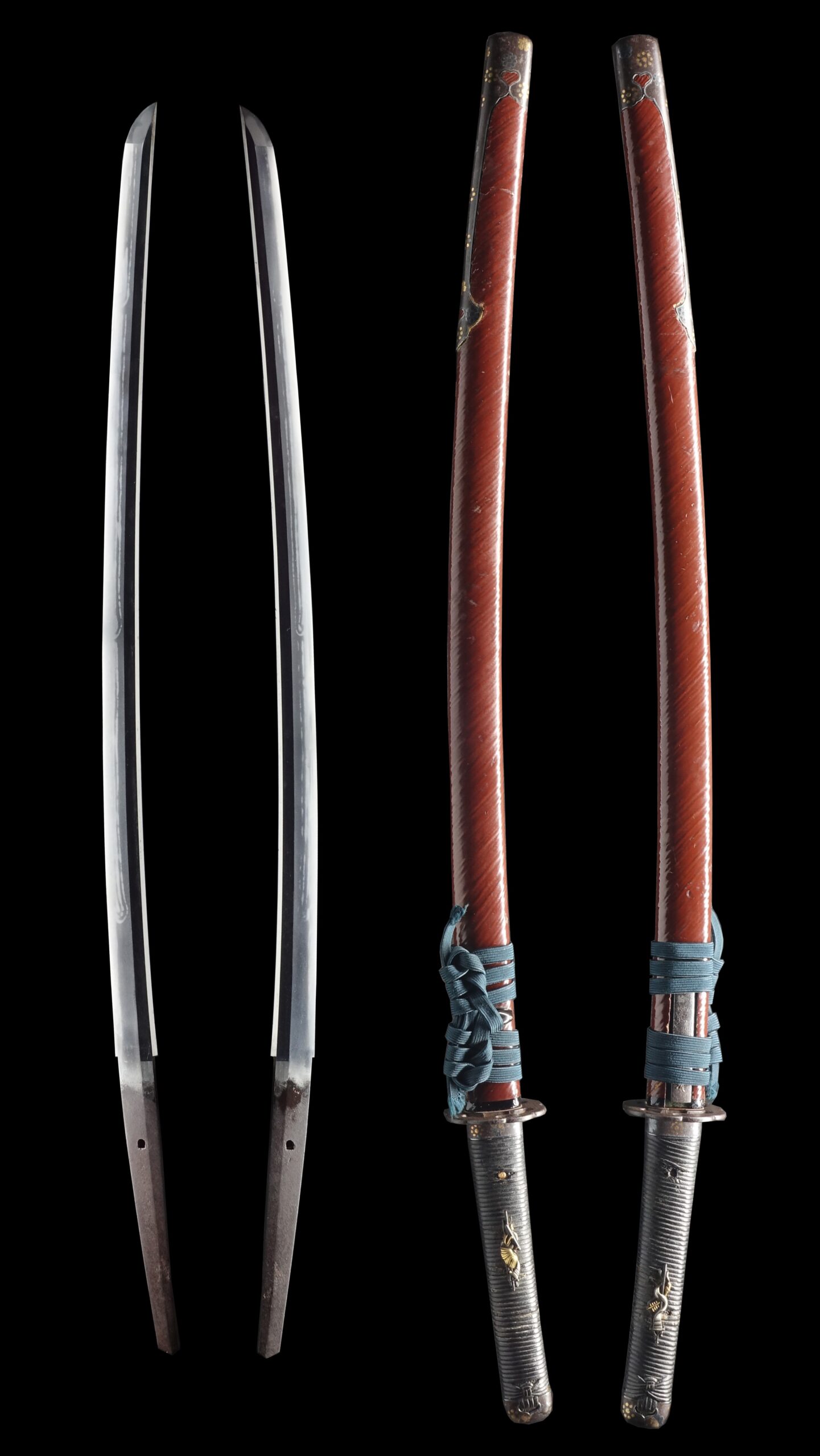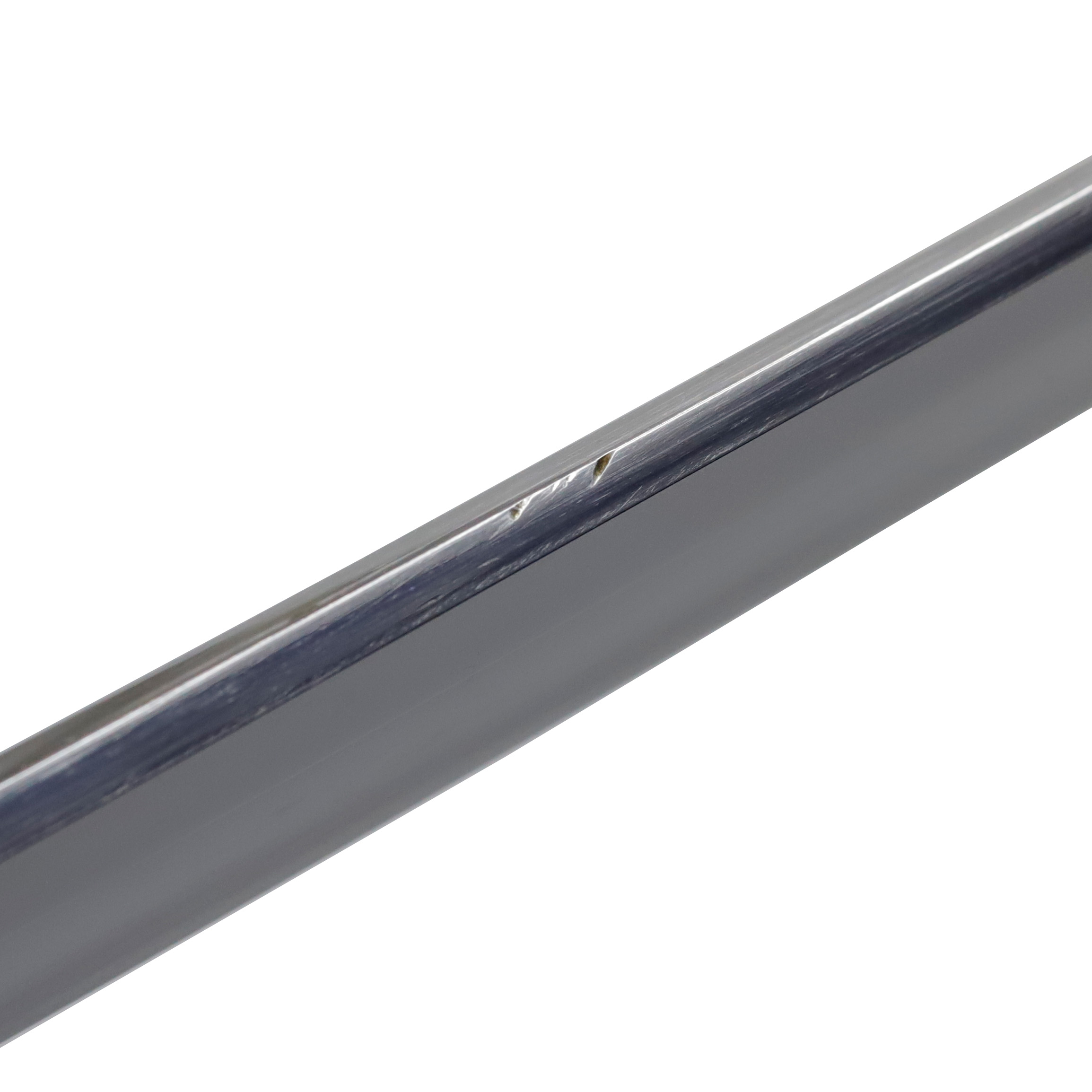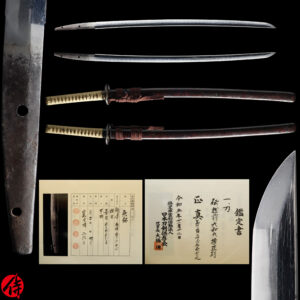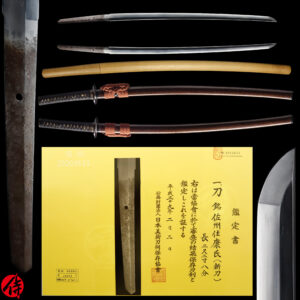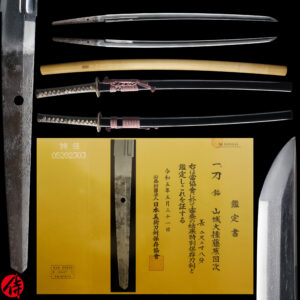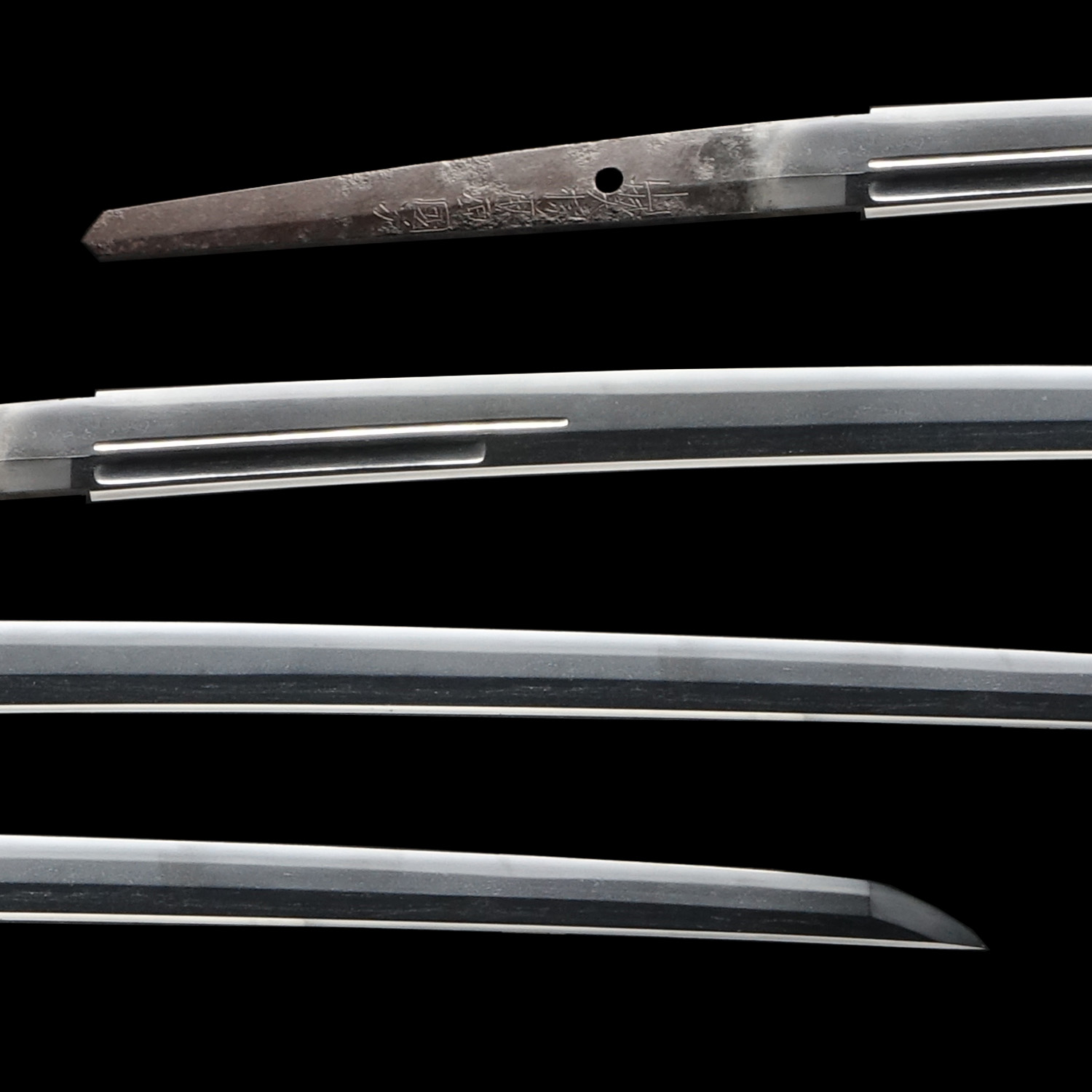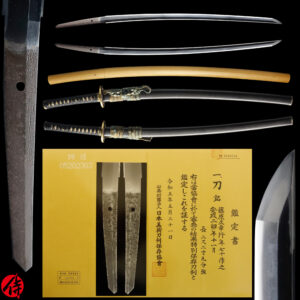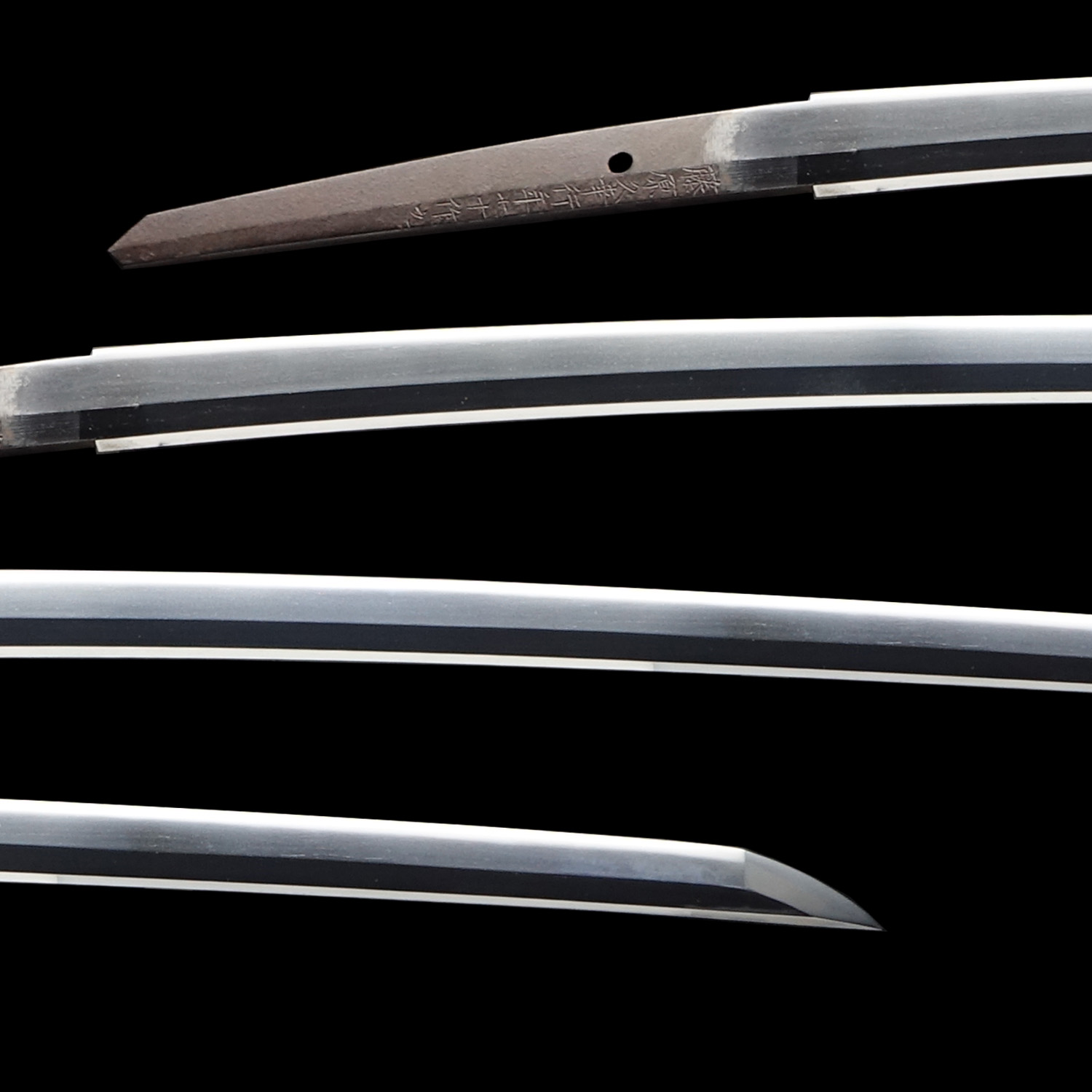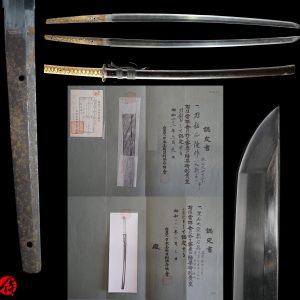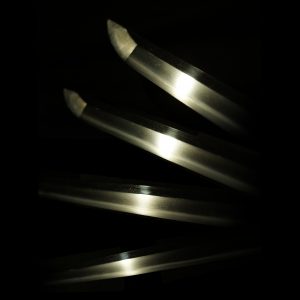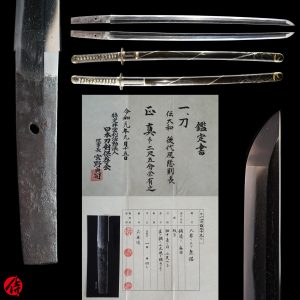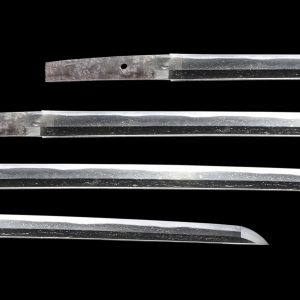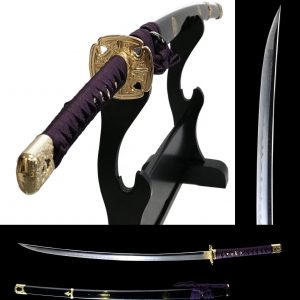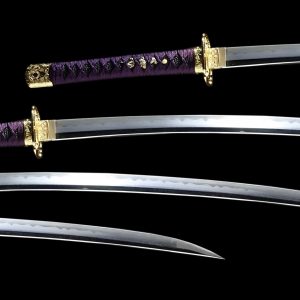Antique Japanese Sword Katana attributed to Tanba no Kami Yoshimichi with NBTHK Hozon Certificate
【Description】
Summary
This blade is attributed to Tanba no Kami Yoshimichi(丹波守吉道), whose real name was Mishina Kinuemon (三品金右衛門). He was active in sword-forging during the early Edo period (Mid-Late 17th century ) in Osaka. He belonged to Osaka Mishina school, one of the most prestigious schools back then.
The swordsmith Yoshimichi prospered in Osaka and Kyoto for generations during the Edo period. And to distinguish the two Yoshimichi, The one in Osaka is called Osaka Yoshimichi, and the other one is called Kyo Yoshimichi. And, we believe the attribution was give to the first-gen Osaka Yoshimichi.
The first-gen Osaka Yoshimichi was born in the third year of the Keicho era (1598) as the second son of the first-gen Kyo Tanba no Kami Yoshimichi in Kyoto. His father was one of the most skilled sword makers in Kyoto city, and Yoshimichi learned sword-forging skills from him first. Later, he received the honorable official title Tanba no Kami and moved to Osaka city during the Seiho era (1644-1648). He was especially active in sword-forging during the Jo-Ou era (1652-1655). He became an independent swordsmith in Osaka city and made the fame of Mishina school spread in Osaka.
His father developed a unique Hamon pattern(tempering line) called Sudareba(簾刃). Sudare means traditional screens or blinds in Japanese. The Hamon pattern he invented resembles its appearance to Sudare. This blade has a beautiful Sudareba Hamon. This special characteristic was passed down to the first-gen Osaka Yoshimichi.
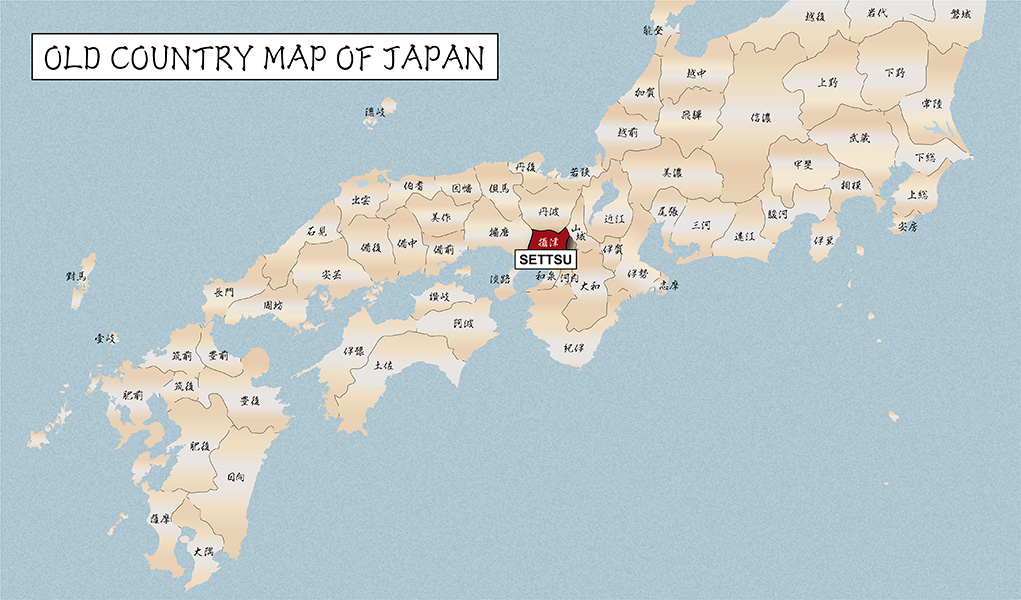
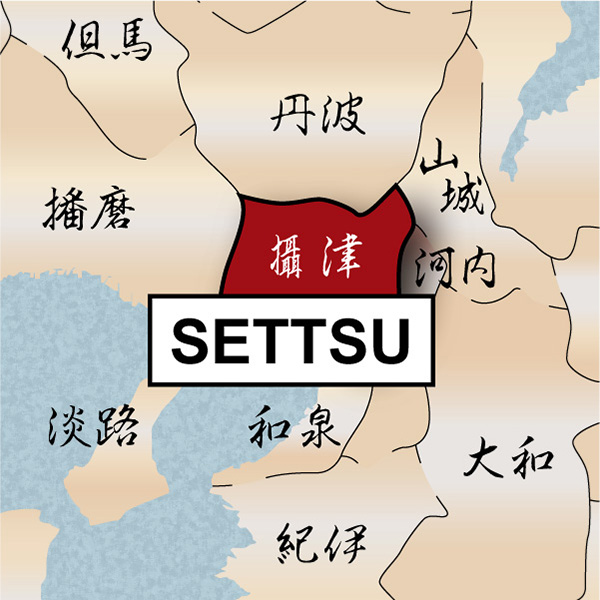
Mishina School
The first-gen Kyo Tanba no Kami Yoshimichi belonged to Kyoto Mishina school and was one of the sons of the Mishina school’s founder. Mishina school was created by the first-gen Mutsu no Kami Omichi (陸奥守大道), also known as Kanemichi. It is said that initially, Kanemichi was from Mino province, exclusively forging blades for Shingen Takeda, a famous feudal lord. Later on, he moved to Kyoto by bringing his four sons and founded his school in Kyoto. Five sons were Iga no Kami Kinmichi(伊賀守金道)、Izumi no Kami Rai Kinmichi(和泉守来金道), Tanba no Kami Yoshimichi(丹波守吉道) and Echu no kami Masatoshi(越中守正俊). His sons were known as Kyoto Gokaji(京都五鍛冶), prestigious swordsmiths forging in Kyoto in the early Edo period.
Osaka Shinto
The blades forged by Tanba no Kami Yoshimichi are categorized as Osaka Shinto. Shinto is Japanese Sword terminology that refers to the swords forged during 1596-1781. The blades made in the Osaka area during this period are called Osaka Shinto. There are many famous swordsmiths in this Osaka Shinto era. After Hideyoshi Toyotomi built Osaka castle, Osaka city flourished as a castle town and became the business center. Many swordsmiths moved to Osaka to look for better opportunities. They not only forged swords for those Samurai who lived in Osaka but also for feudal lords nationwide.
One of the most notable characteristics of Osaka Shinto is its beauty in Jigane. Jigane is a visible steel surface pattern created by folding and hammering during the forging process), which made it possible by the location of Osaka. Osaka had close access to the Tamahagane(special carbon steel to make Japanese swords) production sites. The swordsmiths residing in Osaka were able to get high-quality carbon steel from these sites.
This blade is appraised as a Hozon Touken (保存刀剣) issued by NBTHK (Nihon Bijutsu Touken Hozon Kyokai: 日本美術刀剣保存協会). This authentication paper was only given to authentic Japanese swords, well preserved and high quality with artistic value.
*Please keep in mind that there are a couple of visible Kitae Kizu on this blade. If you like to see the detailed condition, please feel free to contact us.
【Blade】
Cutting Edge Length (Nagasa): 70.2 cm ( 27.6 inches)
Curvature (Sori): 1.4 cm (0.55 inches)


Hamon:
The crystalline structure which forms along the cutting edge of a blade as a result of the hardening process.
Jimon (Jihada):
Visible steel surface pattern created by folding and hammering during forging process.
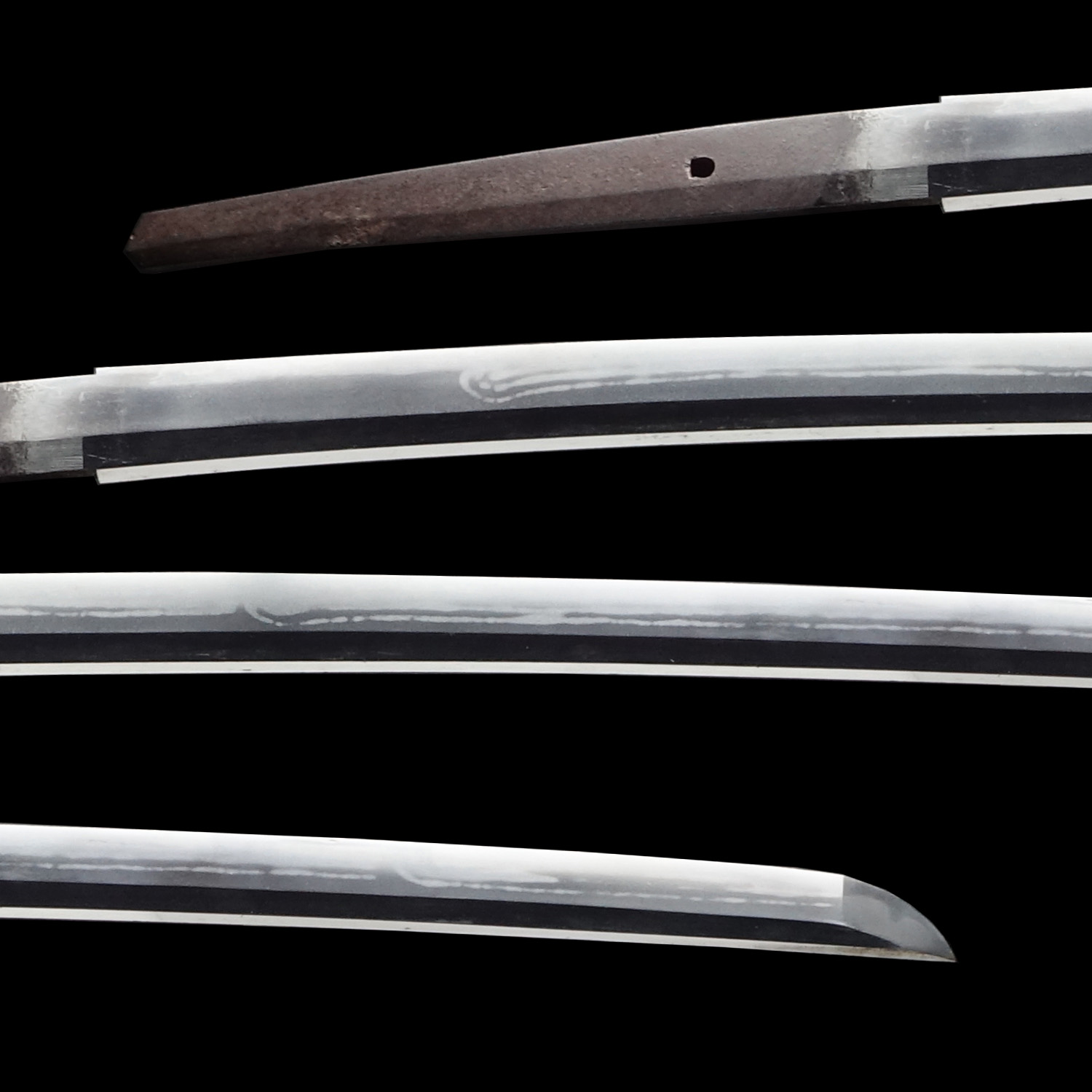
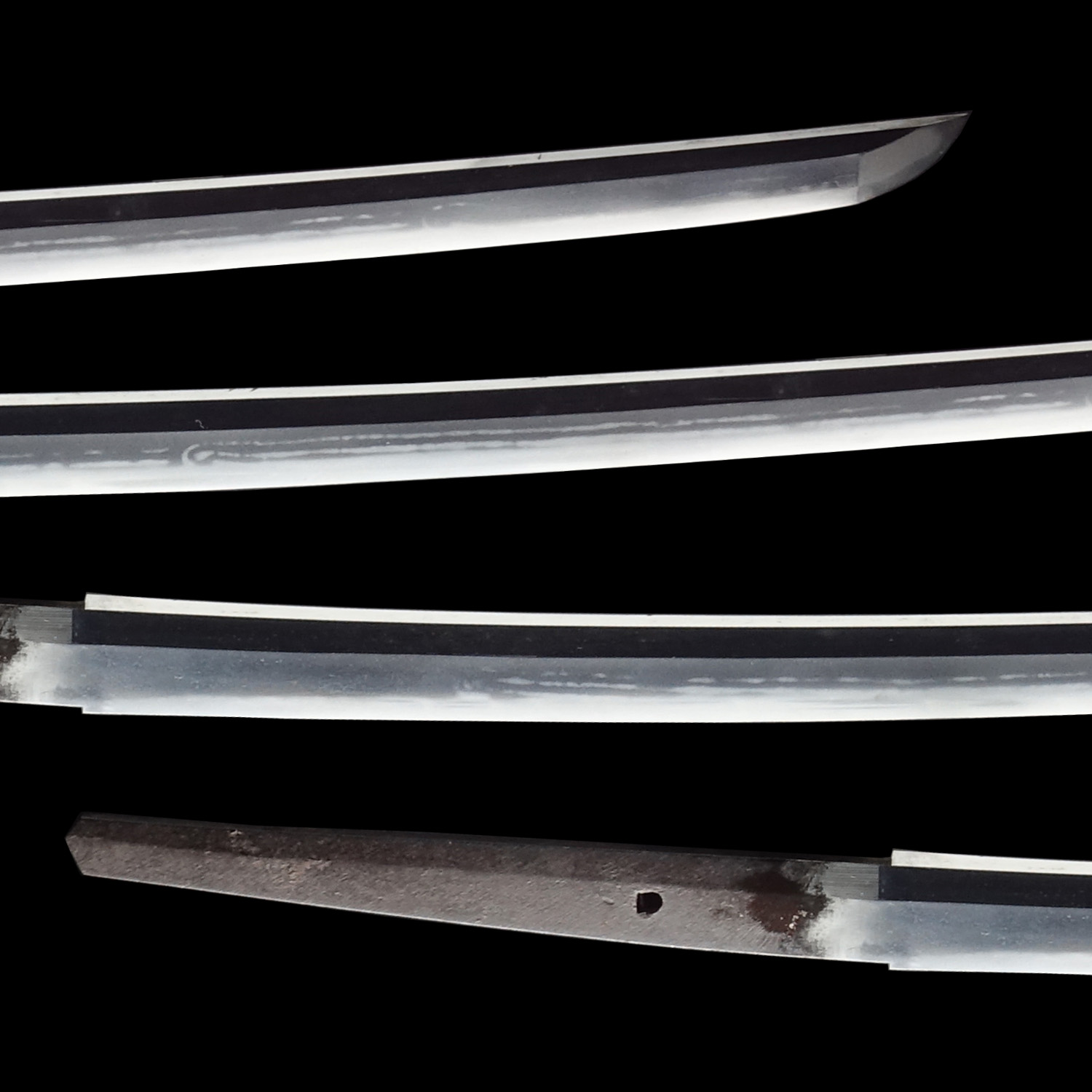
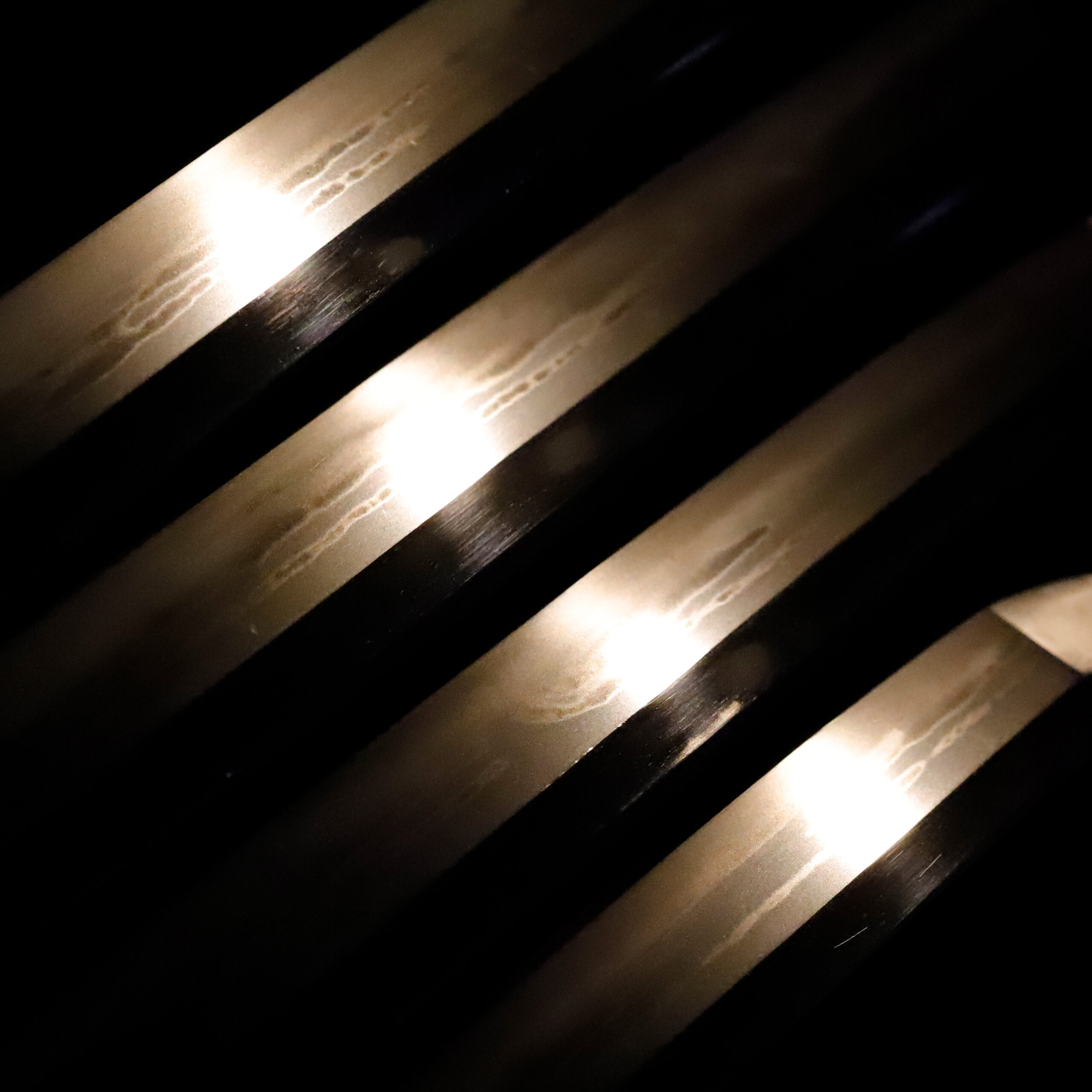



Nakago: Nakago is the tang of the Japanese sword.
Japanese swordsmiths left the black rust on the tang because it prevents red rust while the tang is in its handle. And the discoloration of the tang was created over time, and it is a great indicator for a Japanese sword specialist to estimate when the sword was forged.
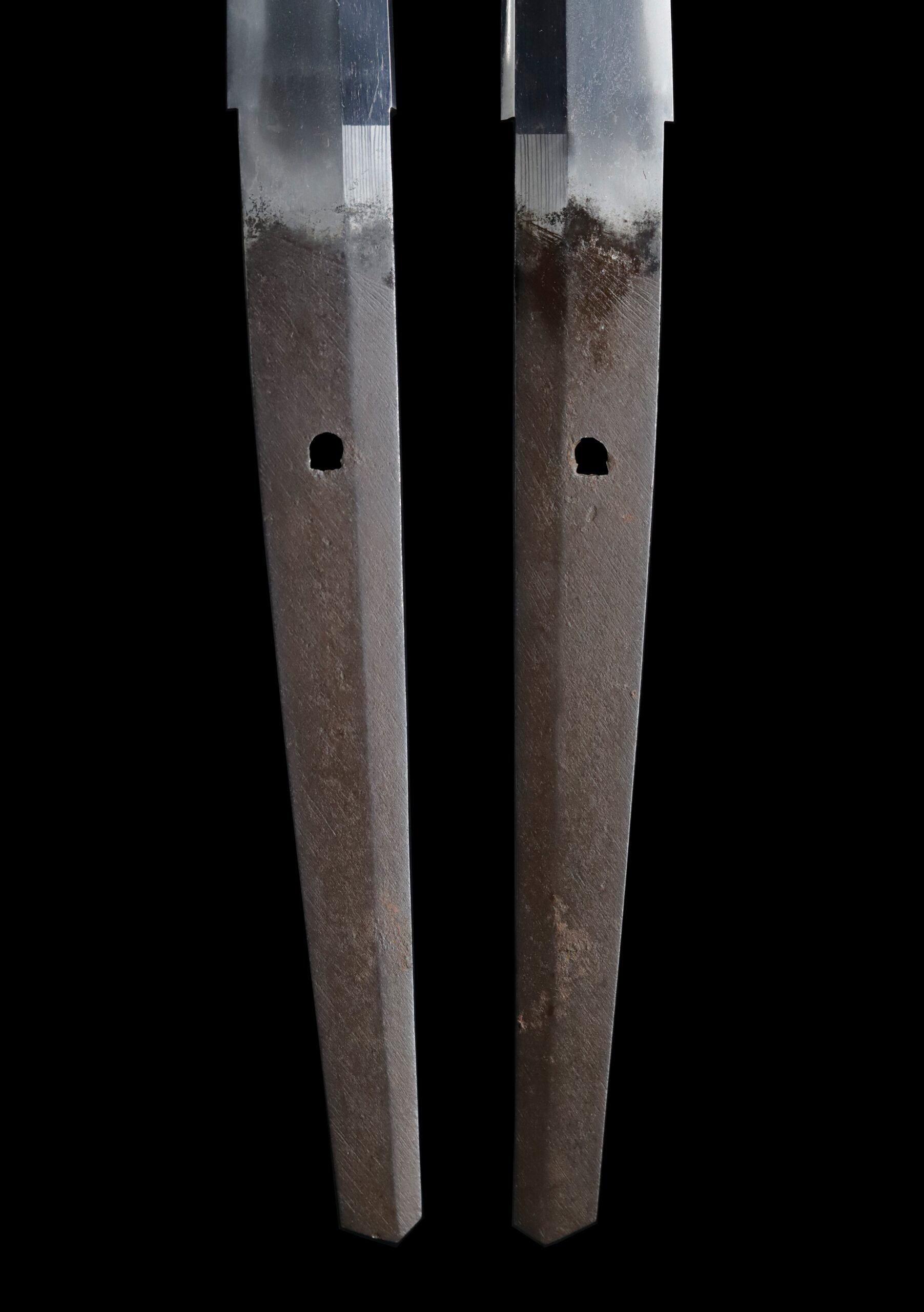
Koshirae: Koshirae is the mounting of the Japanese sword. There are several parts that consist of Koshirae such as Saya (Scabbard), Tsuka (Handle), Tsuba (Handguard).
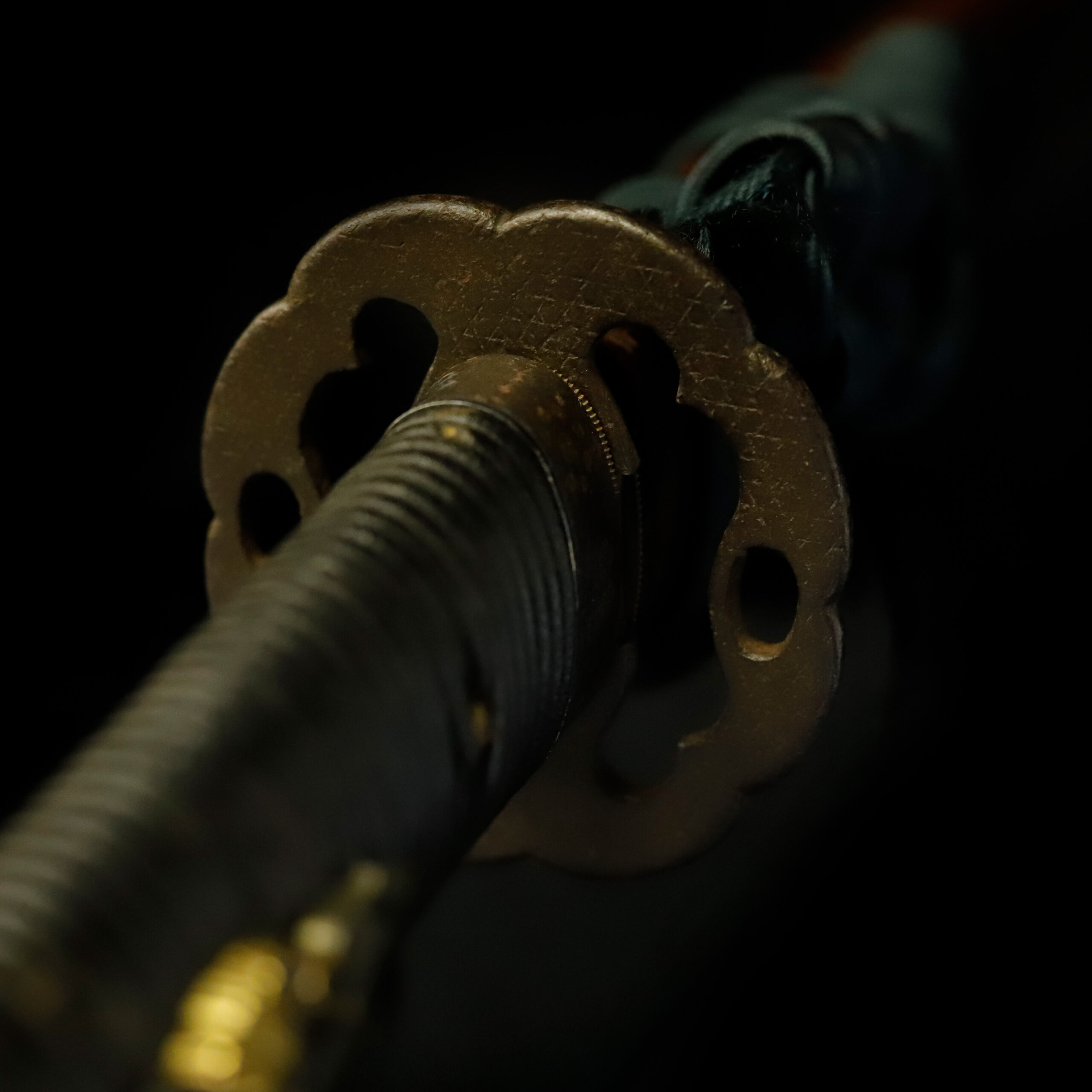
Fuchi-Kashira: A pair of matching sword fittings that cover the upper and bottom parts of its sword hilt.
This Fuchi Kashira is decorated with two symbols: cherry blossom and Kuyou (九曜) patterns. Although some colorings have already faded due to aging, we could see the traces that golden paint was initially applied to each motif. You would find the same designed metal fitting at the tip of the scabbard.
Cherry blossom is one of the seasonal things of spring, and it has been loved for a long time in Japan. A theory says that the god of grain exists in cherry blossoms. Therefore, this flower pattern has been treated as the symbol of a plentiful harvest. The Kuyou pattern is a kind of family crest called the Hoshi (星, star) design. As its name implies, each circle represents a star. Stars have been worshipped as a holy existence that controls fate. Since each star moves in a fixed orbit, people could know the position during hunting or voyages or the agriculture season. That is, stars have a deep relationship with people’s daily life. With time, stars came to be treated as a design, and some people arranged it for their family crests. The Kuyou pattern is one of them. There are various types of Hoshi Mon, such as three stars, seven stars, and nine stars as this work. Three stars design is called the Mitsu-Boshi (三つ星) in Japanese, and it means the Kachi-Boshi (勝ち星, winning star). For warriors who lived on the battlefields, it is understandable that many Samurais loved such an auspicious motif. For example, Date Masamune (1567-1636), one of the famous warlords, used Kuyou Mon for one of his family crests.

Tsuka and Menuki: Tsuka is the handle of the Japanese sword and Menuki is its decoration.
This Menuki’s design is a combination of Samurai-related tools. For example, there is a long stick with a strip of cloth is attached. We believe it is a Hatajirushi (旗印). Flags with letters or family crests on them were used on the battlefield to show one’s affiliation.
On the upper side Menuki, you would find a Saihai (采配), which is a tool made by attaching strips of cloth or paper to the end of a stick so that it could be seen from a distance. It began to be used around the end of the Muromachi period (室町時代, 1336-1573) and is also written as 采幣, 再拝, or 采 in Japanese. This item initially comes from the Sai (旄), a tool used to call a tamed falcon, and its name influenced the name of Saihai. Those who could use a Saihai were limited to the commander of the Ashigaru (足軽, foot soldier) or above or Samurai warriors who had notable military exploits. Being allowed to possess this tool meant commanding a unit, and it was a convenient tool. At the same time, it also had a strong meaning of showing the rank and authority of a military commander. In an actual battle, the movement of the troops was controlled in detail by swinging the Saihai, such as using it as a signal to advance. The signal from this tool differs depending on each military commander, and there is no set pattern. Therefore, it was necessary for the soldiers who received the order to understand the content of the signal perfectly. A theory says that warlords chose their Saihais according to their preferences in the Warring States period. However, in the Edo period, when battles were abolished, this tool became more meaningful than ever as a symbol of authority. The Tokugawa (徳川) family, who ruled the Edo Shogunate, restricted the ownership of these tools based on social status. Saihais were generally made of paper or yak tail hair.
If you focus on the lower side Menuki, you would find a Gunbai (軍配, Sumo referee’s fan today) is incorporated here. The Gunbai is a tool that is related to the Samurai culture. Its shape is an Uchiwa (団扇, Japanese fan) shape. Fans were brought to Japan from the continent in the Nara period (710-794). According to a theory, Uchiwas were used in the court or the aristocracy back then. In addition, after the Ohnin-Bunmei era (応仁・文明年間, 1467-1487), military commanders used Gunbai-Uchiwa (軍配団扇), which is made of leather or iron. They encouraged their subordinates by using it. Also, it was used for ordering the arrangement of an army: For example, the placement of troops, the date and time of the advance, and retreat. It is the origin of the Gunbai, which Sumo (相撲, Japanese wrestling) referees use to judge victory or defeat today. In this way, metalworks that incorporate motifs related to Samurai costumes into sword mountings are often seen. It might have encouraged Samurai warriors who went to battlefields.

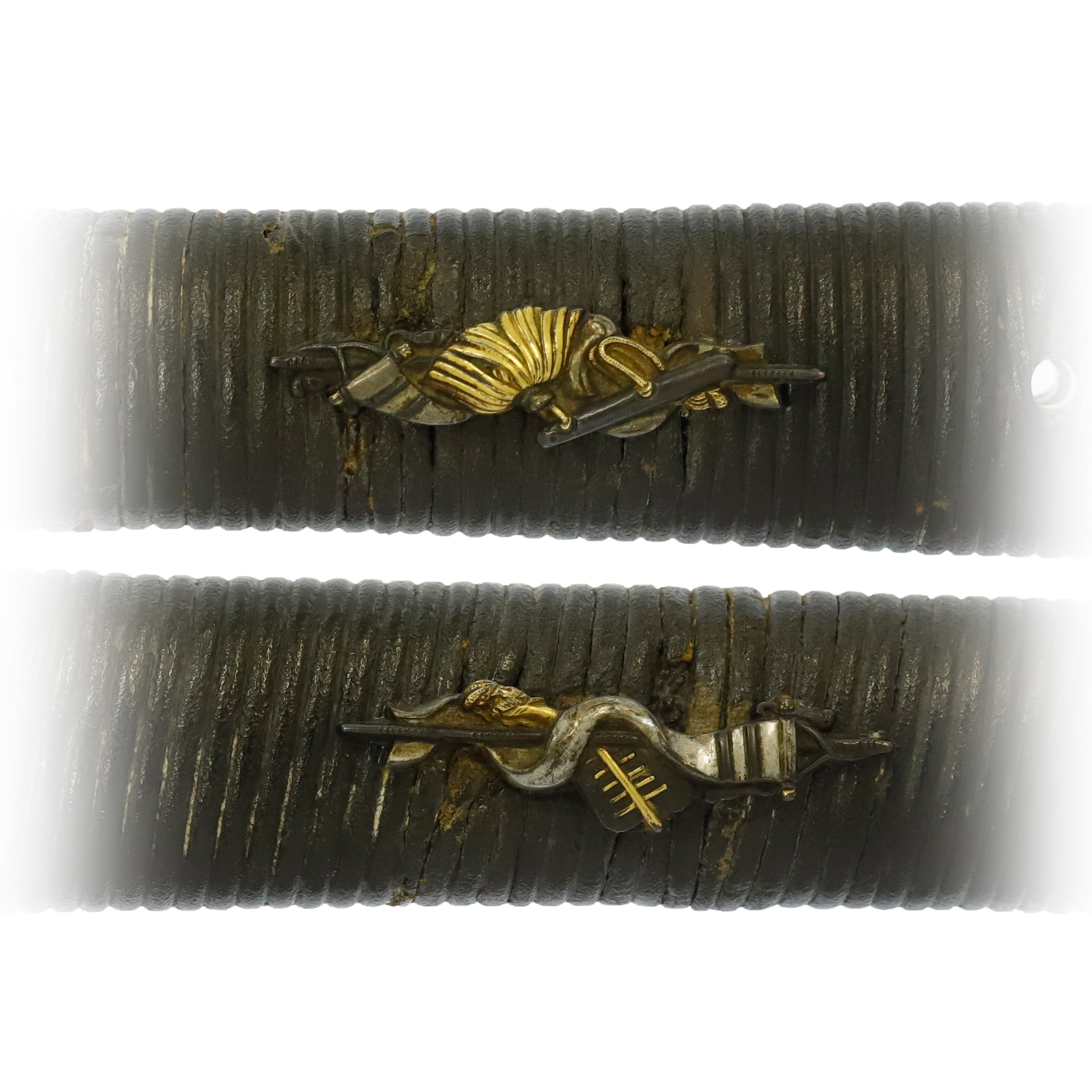
Tsuba and Habaki: Tsuba is the handguard for the Japanese Sword and Habaki is the equipment to make the blade not touch its scabbard inside. It prevents the blade from getting rusty and chipped.
This iron Tsuba has a Yatsu-Mokkou (八ツ木瓜) shape. The carving lines on its surface have worn down over time and are challenging to see now. However, it appears that the Kagome (籠目) pattern is engraved on both sides. As a design, Kagome means a mesh of baskets made from bamboo or a continuous grid of braid. It looks like a group of hexagram shapes. Each pattern is composed of a star-shaped figure of equilateral triangles. Some people believed this motif had the power to exorcise evil spirits; therefore, the Kagome pattern has been used as a talisman. Since ancient times in Japan, people have considered that evil spirits and monsters do not like being gazed at by eyes. As the Kagome pattern gaps are regarded as “eyes,” people once thought of this design’s sacred power.
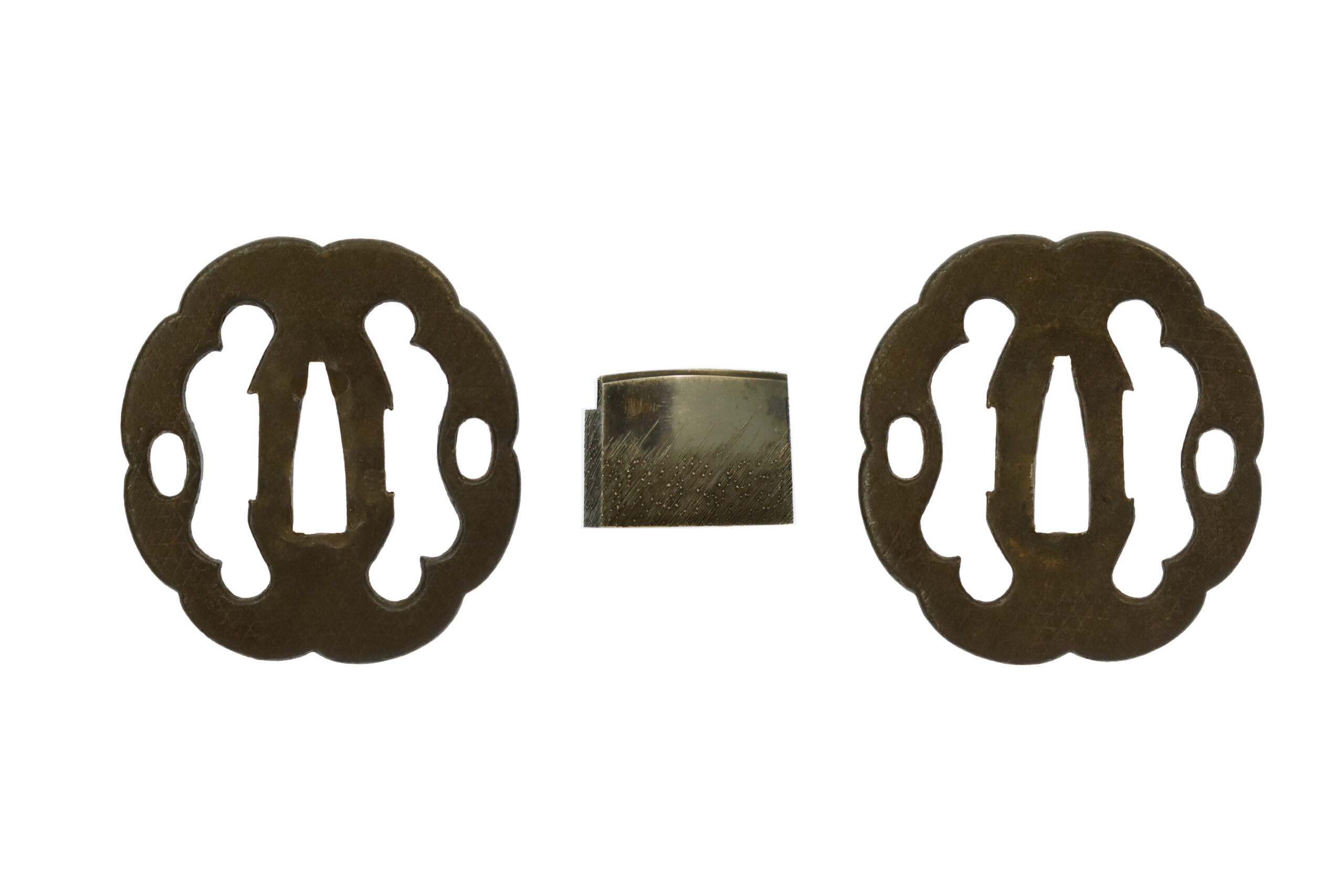
Kozuka:Kozuka is a small knife stored in Kozuka Hitsu(groove of the sheath of the Japanese sword).
A Kogatana (小刀, small knife) is stored in the Kozuka. Both the blade and the handle have rusted due to aging, and the carved texts are difficult to read. Perhaps the person depicted on the Kozuka is a lone fisherman. He is holding something that seems to be a long fishing rod in his hand.


Saya: Saya is the scabbard for the Japanese sword.
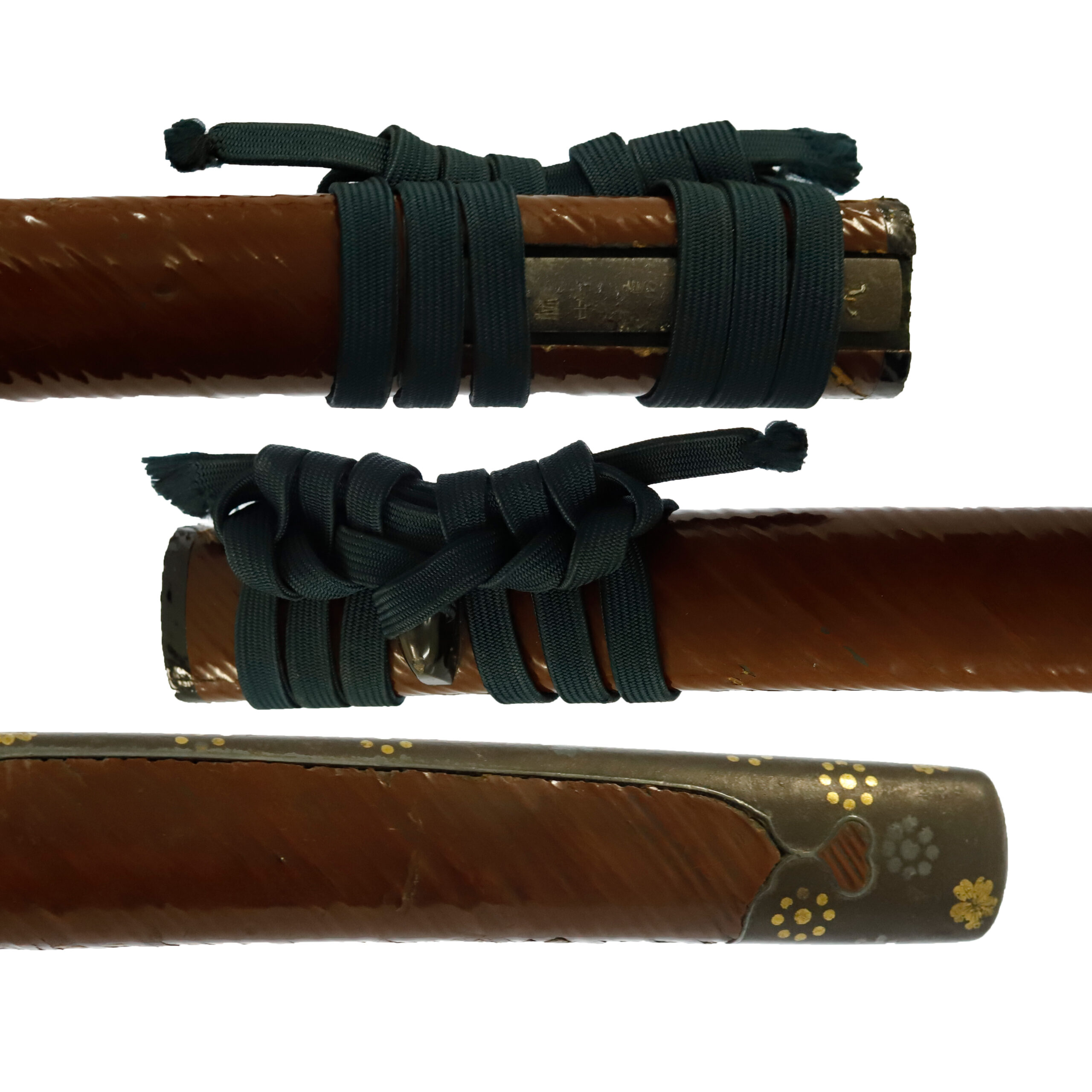
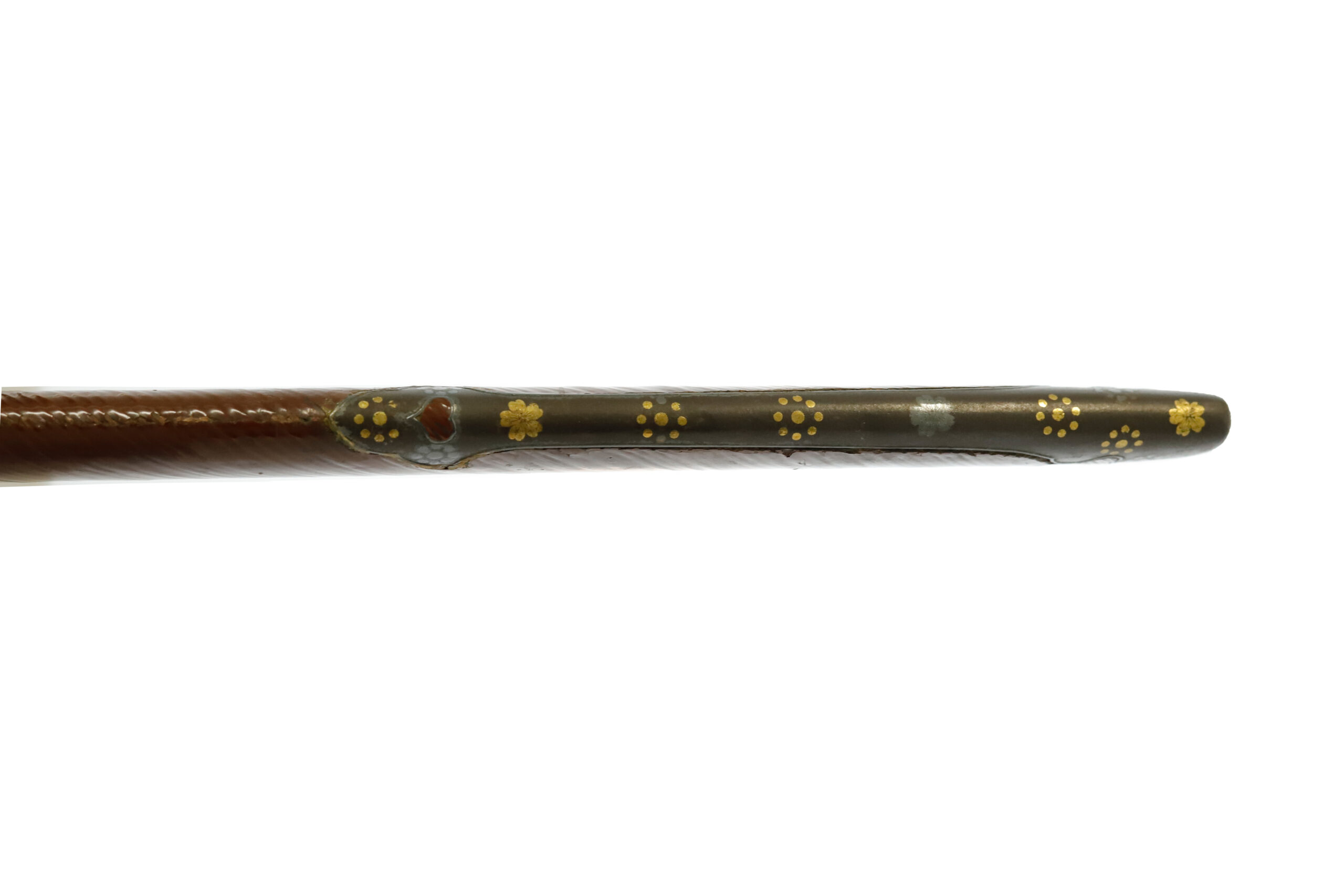
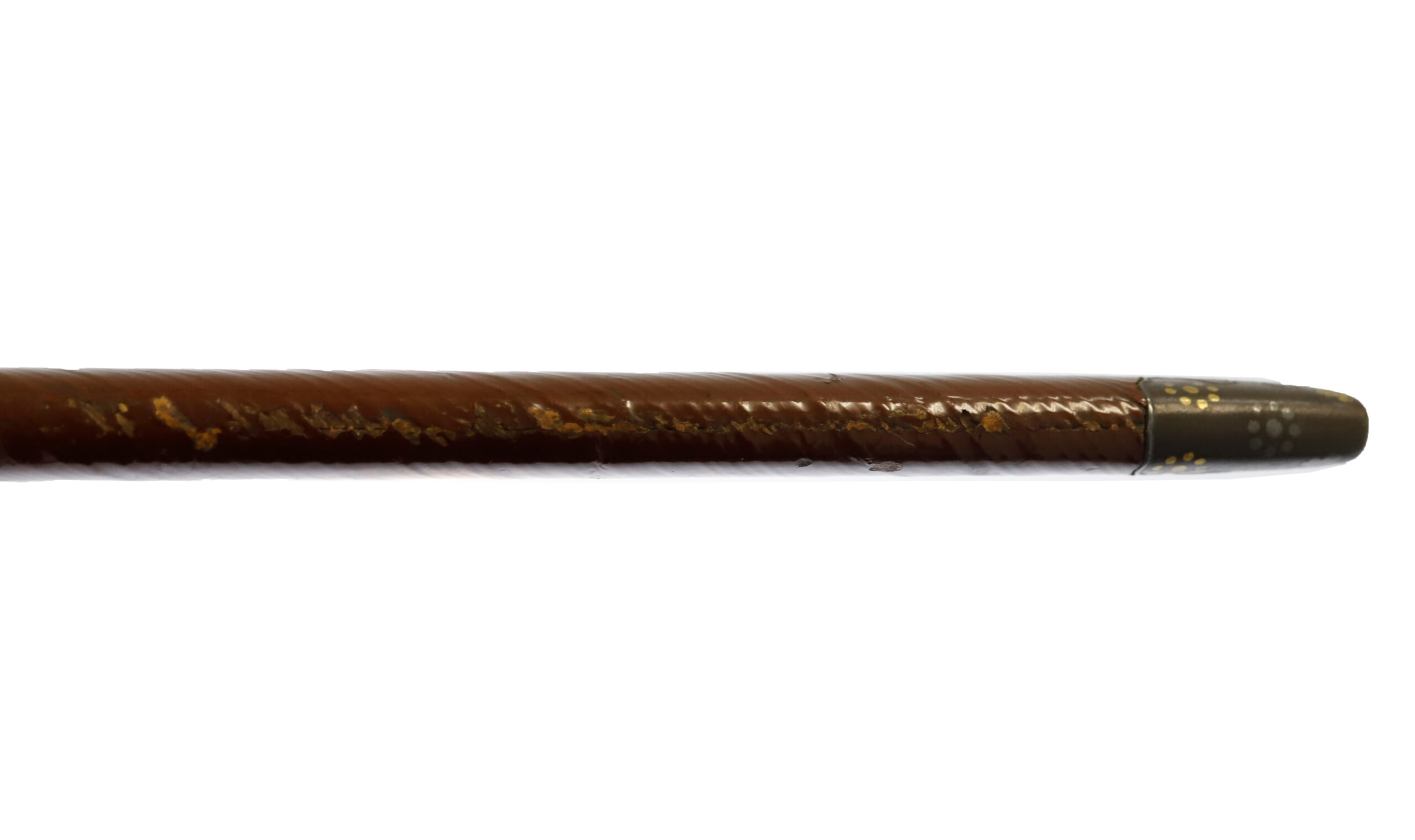
Authentication Paper: NBTHK Hozon Certificate for the blade (No.389866)
NBTHK, also known as Nihon Bijutsu Touken Hozon Kyokai (the Society for the Preservation of the Japan Art Sword), is one of the oldest Japanese sword appraising organizations in modern-day Japan. They authenticated the blade on Jan 27th in the 24th year of Heisei (2012). They appraised it as Hozon Touken, the blade worth preserving for Japanese society. The purchaser will receive this original certificate as well. We can also translate what is written into English and make a PDF file for your record if you request.

Registration Number: Hyogo 67199
The Board of Education in Hyogo prefecture issued a registration paper for this sword. It is called Jyu Token Rui Torokusho (銃刀剣類登録証). Bunkacho (The Agency for Cultural Affairs) acknowledges a Japanese sword with this paper as a work of art.
The sword needs to be traditionally hand-forged and made of Tamahagane carbon steel to be registered in the system. With this paper, its owner in Japan can legally own an authentic Japanese sword. Based on this registration number, we will apply for its export permit.
This paper will need to be returned to the board of education when the sword is being shipped abroad, but you can receive a copy of it. An English translation of this registration paper is available on request.
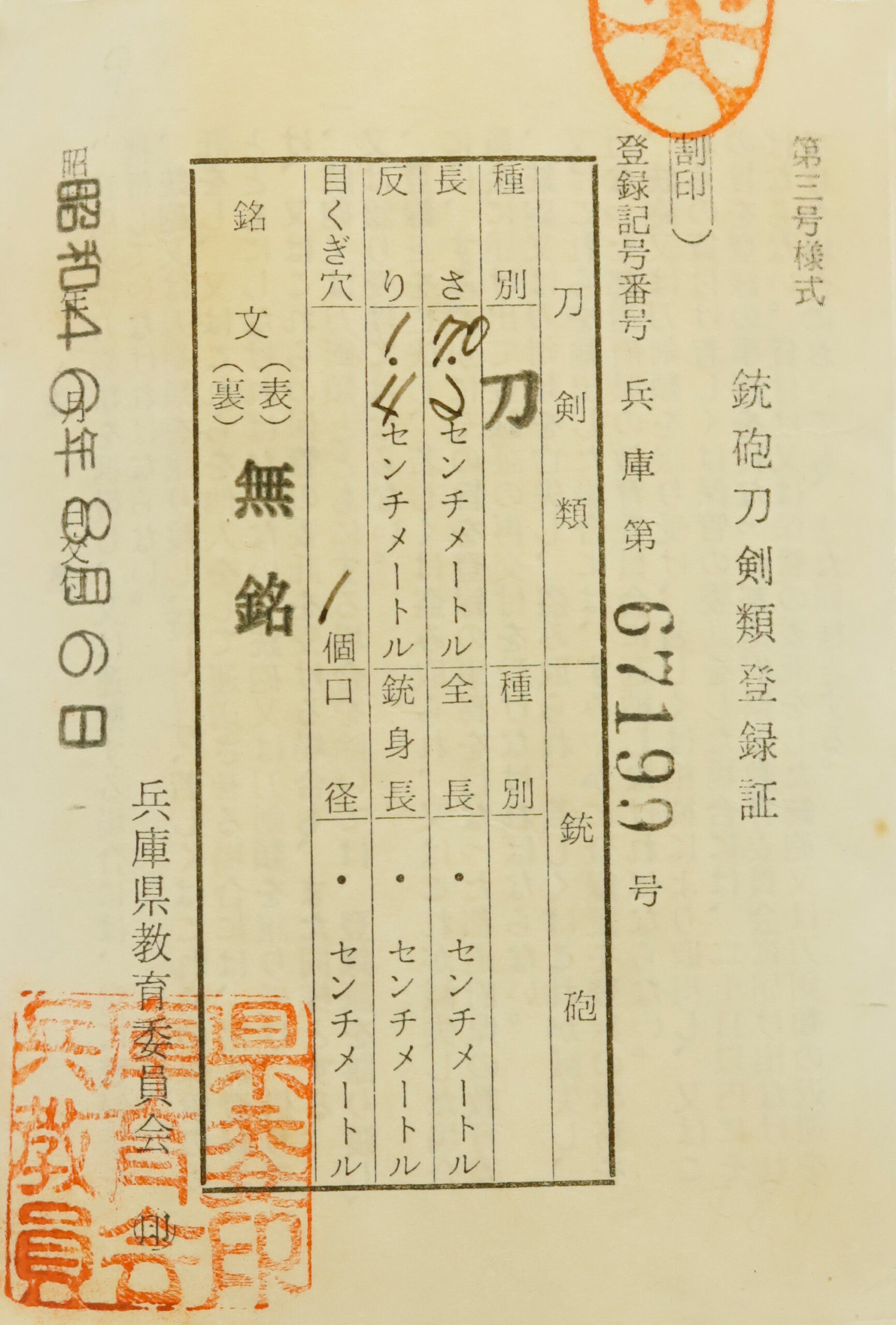

【About us】
Samurai Museum is located in Tokyo, Japan, exhibiting antique artifacts related to the Samurai history. Samurai Museum Shop is the place for those who are interested in Japanese culture and craftsmanship. We deal with antique Samurai swords/armor, traditional crafts made in Japan and so on.
【Review】
Here is one of the reviews we received from a customer who purchased an authentic Japanese sword from us. For more reviews, please click here.
“My experience overall with the whole process was wonderful. I had many questions about the history and process to purchase these treasures. All my questions were answered very timely and complete. The staff is very knowledgeable and very well versed if any questions do arise.”
【Japanese Sword& Export Process】
The Japanese swords we deal with are hand-forged edged swords made in Japan. It was made from the traditional carbon steel called TAMAHAGANE (玉鋼). Samurai Museum is familiar with the proper legal procedure for an antique/ authentic Japanese sword to be exported from Japan. We have sent more than 500 Japanese swords for the past three years (~2023) to amazing owners who appreciate its historical value.
Each Japanese sword is registered under the Agency for Cultural Affairs and the Board of Education in Japan. They issue a registration paper for each Japanese sword for its owner in Japan to legally possess it. The Japanese sword with its registration paper means it was traditionally hand-forged in Japan.
To legally export the sword from Japan to other countries, we will have to apply for its permit to the Agency for Cultural Affairs (Bunkacho) and return the original registration paper to the Board of Education. It normally takes around 2-4 weeks to receive this permit after submitting required documents. And we would like you to expect at least 1-1.5 months for your order to arrive at your given address after you ordered. For more detailed info, please click here.
It is allowed for residents in Japan to own authentic Japanese swords without a special license as long as they come with registration papers. Please feel free to contact us if you are a resident of Japan, whether temporarily or permanently. We will also assist you when you leave Japan and need to obtain the export permit.
【Payment Method】
We accept payment through Stripe (Credit card), PayPal, Apple Pay or ChromePay, all of which are secure payment methods. Also, you don’t need to make an account on Stripe for the checkout. If you prefer other payment method, please contact us. After confirming your payment, we will apply for an export permit. You may either pay in JPY, USD, AUD, CAD, EUR, CHF or GBP. The price is set in Japanese Yen. Prices in other currencies are automatically calculated based on the latest exchange rate.

*If the amount is above 1 million JPY, Stripe or wire transfer will be the only options for payment.
【Shipping】
We have shipped authentic Japanese swords to the USA, UK, Canada, Mexico, Germany, France, Hong Kong and Australia. If you don’t live in these countries and like to order, please contact us first before making a purchase. We offer Free International Shipping as long as we can send antique Japanese swords by EMS.
We normally ship by EMS (Express Mail Service) provided by Japan Post. We will send you a tracking number for your order as soon as we hand it to the post office. We will put 100 % insurance on the shipping document without any extra charge. Based on the total amount, there might be a duty tax or other fee for you to pay, depending on the countries. We use package cushioning to protect the item and put it in a PVC pipe, which is one of the most secure packages because of its durability.
It will normally take 5-14 days for the item to arrive at your given address after we dispatch it. Time of delivery is estimated as accurately as possible by the carrier but does not take into account any delays beyond our control such as by inclement weather, post office holiday seasons.
*If you live in Australia and like to purchase an authentic Japanese sword, please click here to know the detail.
*Please keep in mind that due to the spread of COVID-19, there might be delays in shipping. If you like to know the detail about shipping, please feel free to ask us.

【How to make sure the condition】
Please keep in mind that what you are going to purchase is an antique item. We uploaded high resolution photos for you to check its condition thoroughly. If you like to see more photos with different angles, please feel free to contact us. We will be happy to send them to you so that you can make informed decision. It is essential for us to know that you are happy with your choice of a sword. and we are prepared to use the best of our ability to serve you.
【How To Contact Us】
Please contact us through email, Facebook Messenger or Live Chat if you have any questions. You can find each icon on the right side of the website. Please click one of them to reach us. We will reply to you within 1-2 business days.
【The Art of Nihonto (Japanese Sword) 】
Samurai’s history is a profound, eloquent legacy of ancient Japanese warriors in which millions of people worldwide are being fascinated. If you like to find out the art of Nihonto, please click here.
【A Guide to Japanese Sword Maintenance】
After acquiring a genuine Japanese sword, it is also important to know how to take good care of it. Here is the special video for you. Mr. Paul Martin, Japanese sword expert, shows you how to give proper maintenance to your sword. By mastering how to clean the Japanese sword, its aesthetic beauty will last forever.
When you purchase a Japanese sword from us, you can get a Free Japanese sword maintenance kit. It comes with four tools (Choji Oil, Uchiko Whetstone Powder, Peg remover, Oil Applicator). By watching the video instruction above, you can enjoy learning how to maintain your Japanese sword while appreciating it. If you have any difficulty assembling the sword or cleaning the blade, you can feel free to contact us.


MORE ANTIQUE JAPANESE SWORD FOR SALE
SWORDS WITHOUT CERTIFICATES FOR SALE
LEARN JAPANESE SWORD TERMINOLOGY
Thank you for reading all the information on the page. If you have any difficulty choosing the right Japanese sword for you, we will be more than happy to help you find the one that speaks to you the most. Please feel free to contact us.

